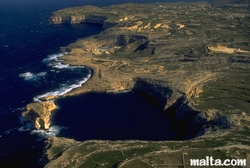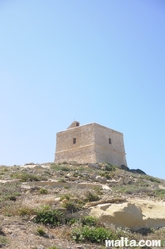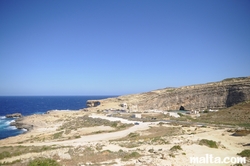Dwejra and The Azure Window, Gozo's pride
 Concentration of natural monuments
Concentration of natural monuments
Located on the West coast of Gozo, Dwejra is perhaps the most spectacular natural monument in Malta.
Geology, time, the elements and human intervention worked together to produce a fascinating area that features the Azure Window, an Inland sea, Fungus Rock, Dwejra bay, the Blue Hole, a watch tower and cart ruts.
Dwejra, which in Maltese means ‘a small house’, got its name from a tiny home built on the cliffs surrounding the inland sea.
The area has rare geological features both on land and underwater, rich and diverse wildlife and habitats and spectacular seascapes dominated by a rocky shoreline. There are some fascinating underwater caves and the nearby Blue Hole that provide excellent dive sites.
Overlooking the bay there is a chapel dedicated to St. Anne, built in 1963 on the site of a much older church. Dwejra is a tourist village that belonging to San Lawrenz for administrative purposes.
The Azure window
The Azure window is a natural arch that looks like a table over the sea. Two almost perpendicular vertical rocks hold a huge horizontal mass over them; a result of extensive fault-ins, as well as the wind and wave action on the rocks. It attracts a huge number of visitors and inspires many artists who paint the magical site on canvas.
It also featured in the movies “The Clash of the Titans” and “The Count of Monte Cristo”. The arch of the window is eroding with the actions of the wind and water; pieces of rock fall every now and then. It is expected that the arch will collapse sooner or later, so it is advisable not to walk on it.
The Inland sea
Known as ‘Il-Qawra’ by the locals, this area constitutes the lowest spot in Gozo. The Inland sea is an expanse of shallow water set in a deep recess in the coastline produced by the collapsing of underwater caves millions of years ago.
The bay is connected to the open Mediterranean Sea via a narrow 60 metre-long tunnel in the cliffs, called Blue Cave because of the colour of the sea within it. There are small fishing boats that can take you from the inland sea, through the tunnel to the open sea with majestic views of Fungus rock and the massive limestone cliffs.
Fungus Rock
The significance of Dwejra Bay is also due to a 65-metre high rock called Fungus Rock, known locally as ‘Il-Gebla tal-General’. The name is derived from a commander of the Knights of St. John, who discovered a plant known as Malta Fungus or Cynomorium coccineum.
This rare parasitic flowering plant was highly prized by the Knights, since they believed it had medicinal properties and used it to dress wounds and as a cure for dysentery. Because of the importance of this plant, the Knights blocked access to the rock by smoothing the cliff sides, and placed a guarded it against intruders. There were tough punishments for trespassers or anyone caught stealing the crop.
Dwejra Coast Watch Tower
The Dwejra tower is situated just off the road that leads to Dwejra bay.
It was built during the reign of Grandmaster Antoine de Paule in 1651, with its main objective being to guard against attacks from the sea, but from 1 744, it acquired another function, that of guarding Fungus rock and the plant that grew on it.
744, it acquired another function, that of guarding Fungus rock and the plant that grew on it.
The tower lost its role as a coast guard in 1873 and was abandoned. In 1997, Din l-Art Helwa, started restoration works on the tower, and now it is open all year from Monday to Friday from 09:00 to 15:00, weekends and public holidays from 12:00 to 15:00.
The Cart Ruts of Dwejra
The couple of deep carved cart ruts in the Dwejra area ascend up the hill at the back of St. Anne’s chapel to the soaring cliffs north of the Inland sea.
The purpose of these ruts is not known, and nobody knows what period of history they represent, but in any case, they are evidence of intense human activity during a particular era.
Apart from the cart ruts, pottery shreds found in the area evidence the presence of the first Neolithic culture of the Maltese Islands, some 7000 years ago.
The Flora around Dwejra
Although the Dwejra area is susceptible to human interference, agriculture and quarrying, it is nevertheless an important site with respect to its ecological value. There is a high level of biodiversity and endemism that was brought about by the Dwejra’s relative isolation and inaccessibility. Species evolved to become endemic or rare.
Dwejra includes various habitats such as: steppe with a variety of grasses, garrigue areas hosting small bushes such as Tree Spurge (Euforbia dendroides), Golden Samphire (Inula crithmoided), and Maltese Salt Tree (Darniella melitensis), rocky shores with endemic sea lavenders, vertical cliffs hosting the Maltese Everlasting (Helichrysum melitense), as well as dry valley systems and freshwater wetlands.
 Fauna & Birds flying over the Dwejra region
Fauna & Birds flying over the Dwejra region
The Maltese Wall lizard is endemic to the Maltese and Pelagic Islands. There are five sub-species known, and the Dwejra area holds two distinct populations, with the Podarcis filfolensis generalensis confined just to Fungus rock. It is characterised by a dark reddish colour on the side, more prominent in males.
Dwejra is also a significant bird breeding and nesting site, especially on the high cliffs where it harbours several rare and endemic species. It is an ideal bird-watching spot particularly when winds from the North east and South east are blowing. The position and landscape of the site draw migratory birds that include wagtails, flycatchers and gulls. Other smaller birds such as the hirundines prefer moving along the coast on reaching the land when migrating. Groups of shorebirds can be seen at times battling against the wind to seek shelter provided by the coast. The cliffs offer good nesting spots for several birds including the Blue Rock Trush, Malta’s National Bird.
The geology present in Dwejra
The geological features present in Dwejra are the result of marine erosion processes. The sea-cliffs are mainly composed of Lower Coralline Limestone, reaching a height of 130 metres. The almost perpendicular cliff face shows that the rock is very resistant to wave action.
The next layer – Globigerina Limestone, is characterised by fossilised remains of sea creatures dating from the Miocene period. Slopes of Blue Clay can be seen in the Qawra valley that leads to the inland sea. When one sees an airline view of the Dwejra area, one can notice at least four circular structures imprinted in rock.
These features were underground caves whose roof collapsed during the Miocene period, forming hollow spaces or even sub-marine basins.


